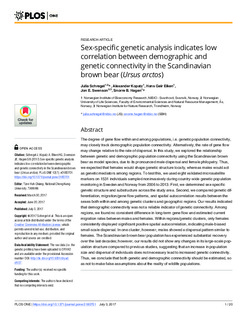| dc.description.abstract | The degree of gene flow within and among populations, i.e. genetic population connectivity, may closely track demographic population connectivity. Alternatively, the rate of gene flow may change relative to the rate of dispersal. In this study, we explored the relationship between genetic and demographic population connectivity using the Scandinavian brown bear as model species, due to its pronounced male dispersal and female philopatry. Thus, we expected that females would shape genetic structure locally, whereas males would act as genetic mediators among regions. To test this, we used eight validated microsatellite markers on 1531 individuals sampled noninvasively during country-wide genetic population monitoring in Sweden and Norway from 2006 to 2013. First, we determined sex-specific genetic structure and substructure across the study area. Second, we compared genetic differentiation, migration/gene flow patterns, and spatial autocorrelation results between the sexes both within and among genetic clusters and geographic regions. Our results indicated that demographic connectivity was not a reliable indicator of genetic connectivity. Among regions, we found no consistent difference in long-term gene flow and estimated current migration rates between males and females. Within regions/genetic clusters, only females consistently displayed significant positive spatial autocorrelation, indicating male-biased small-scale dispersal. In one cluster, however, males showed a dispersal pattern similar to females. The Scandinavian brown bear population has experienced substantial recovery over the last decades; however, our results did not show any changes in its large-scale population structure compared to previous studies, suggesting that an increase in population size and dispersal of individuals does not necessary lead to increased genetic connectivity. Thus, we conclude that both genetic and demographic connectivity should be estimated, so as not to make false assumptions about the reality of wildlife populations. | nb_NO |

